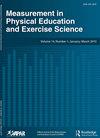设计核心肌肉耐力平板支撑试验健康参考标准
IF 1.9
4区 教育学
Q2 EDUCATION & EDUCATIONAL RESEARCH
Measurement in Physical Education and Exercise Science
Pub Date : 2022-01-02
DOI:10.1080/1091367X.2021.2016409
引用次数: 2
摘要
摘要:我们在10-18岁的葡萄牙健康人群(n=474,46.4%为女性)中制定了基于躯干瘦脂肪比(LM/FM)的平板测试标准。测量身高和体重,并使用俯卧平板测试评估肌肉耐力。使用双能x射线吸收法测定躯干LM/FM比率。Plank标准是使用接收器操作员特性曲线推导的。大约90%具有足够躯干LM/FM比率的年轻人被归类为平板时间的理想区域。躯干LM/FM比率≤第5百分位的患者中,约有三分之二在不良区域内。与得分高于临界点(与年龄、性别或体重状况无关)的人相比,处于不理想平板区的人患低躯干LM/FM的几率高6.5倍。这里提供的标准可用于确定低躯干LM/FM比率,这可能对青少年的平衡和脊柱健康有影响。本文章由计算机程序翻译,如有差异,请以英文原文为准。
Designing Health-referenced Standards for the Plank Test of Core Muscular Endurance
ABSTRACT We developed plank test standards, based on trunk lean mass-to-fat mass (LM/FM) ratio, in a sample of healthy Portuguese 10–18 year olds (n = 474, 46.4% female). Height and weight were measured and muscular endurance was assessed using the prone plank test. Trunk LM/FM ratio was determined using dual-energy x-ray absorptiometry. Plank standards were derived using receiver operator characteristic curves. Approximately 90% of youth with sufficient trunk LM/FM ratio were categorized into the desirable zone of plank time. Roughly two-thirds of those with trunk LM/FM ratio ≤ 5th percentile were identified within the undesirable zone. The odds of low trunk LM/FM were 6.5 times greater for those in the undesirable zone of plank compared those scoring above the cutpoint (independent of age, sex, or weight status). The standards provided here can be used to identify low trunk LM/FM ratio, which may have implications for balance and spinal health in youth.
求助全文
通过发布文献求助,成功后即可免费获取论文全文。
去求助
来源期刊

Measurement in Physical Education and Exercise Science
Medicine-Orthopedics and Sports Medicine
CiteScore
4.20
自引率
33.30%
发文量
24
期刊介绍:
The scope of Measurement in Physical Education and Exercise Science (MPEES) covers original measurement research, special issues, and tutorials within six substantive disciplines of physical education and exercise science. Six of the seven sections of MPEES define the substantive disciplines within the purview of the original research to be published in the journal: Exercise Science, Physical Activity, Physical Education Pedagogy, Psychology, Research Methodology and Statistics, and Sport Management and Administration. The seventh section of MPEES, Tutorial and Teacher’s Toolbox, serves to provide an outlet for review and/or didactic manuscripts to be published in the journal. Special issues provide an avenue for a coherent set of manuscripts (e.g., four to five) to collectively focus in-depth on an important and timely measurement-related issue within the scope of MPEES. The primary aim of MPEES is to publish high-impact manuscripts, most of which will focus on original research, that fit within the scope of the journal.
 求助内容:
求助内容: 应助结果提醒方式:
应助结果提醒方式:


